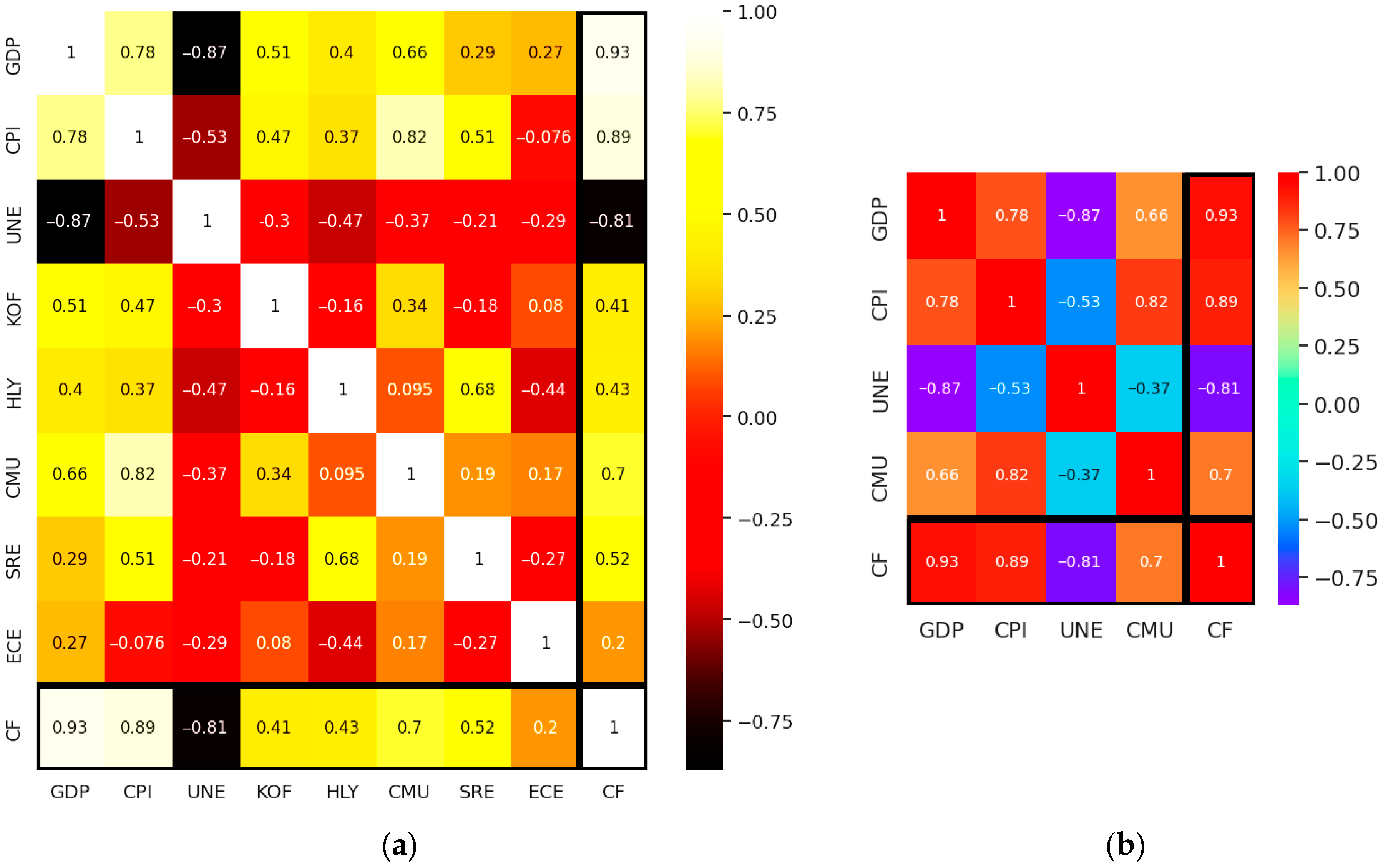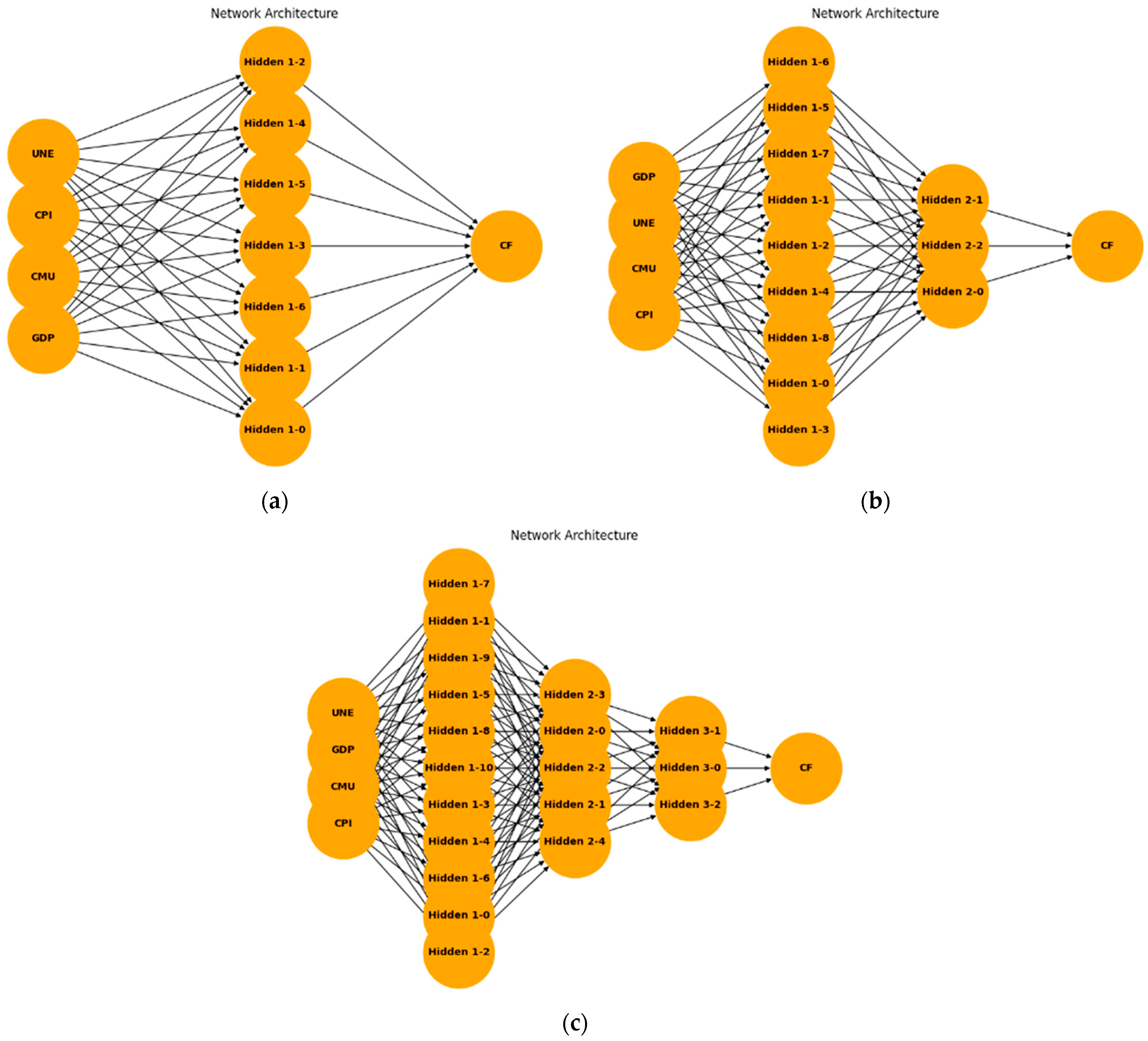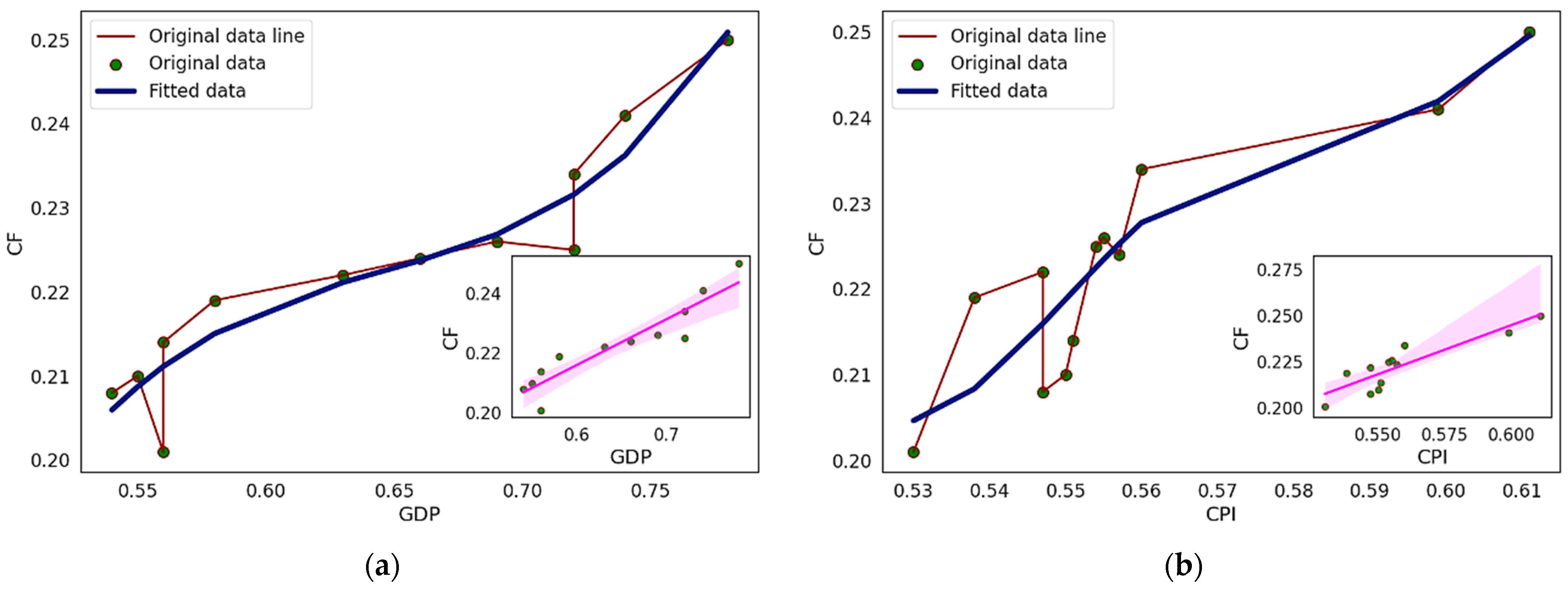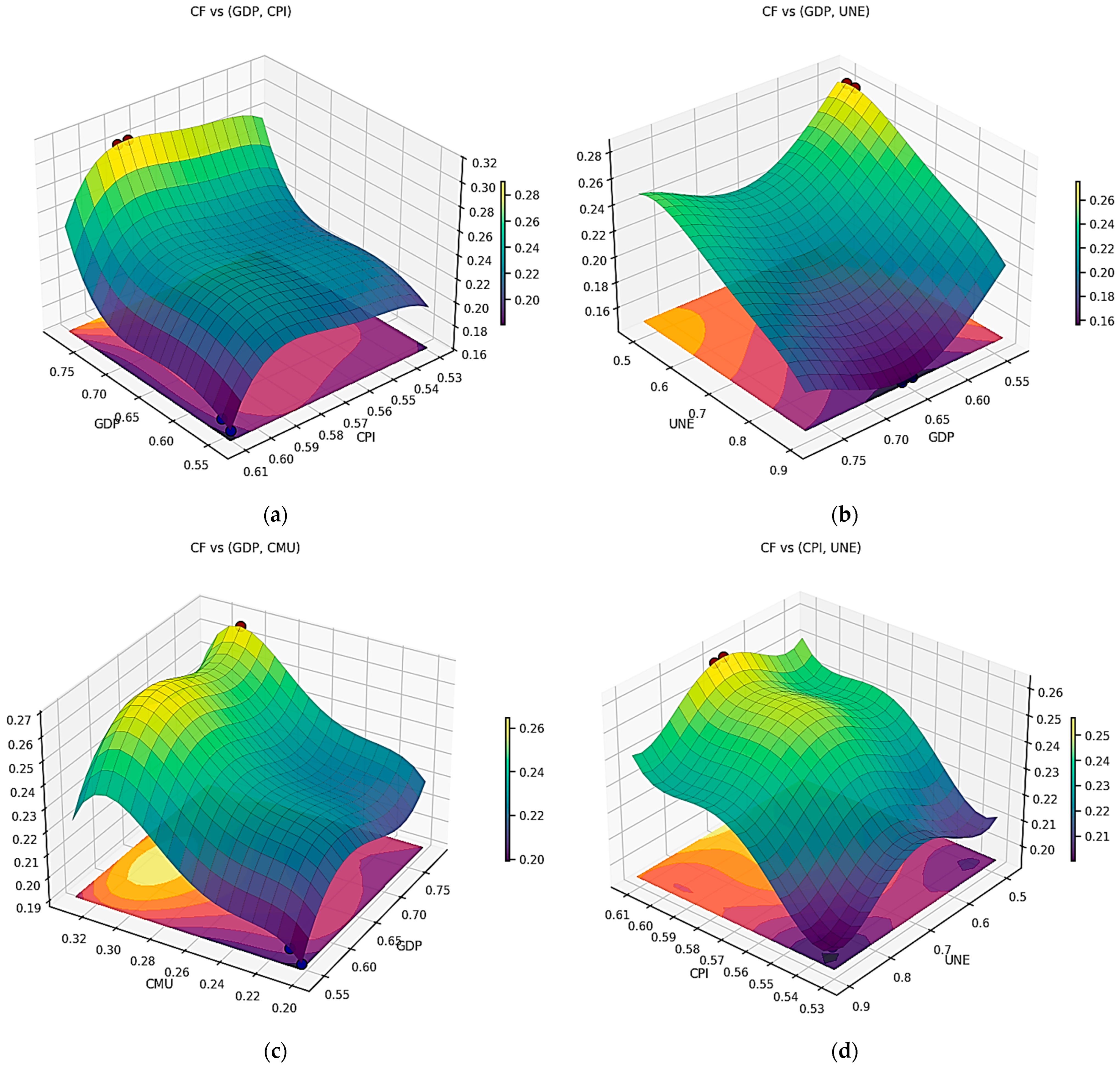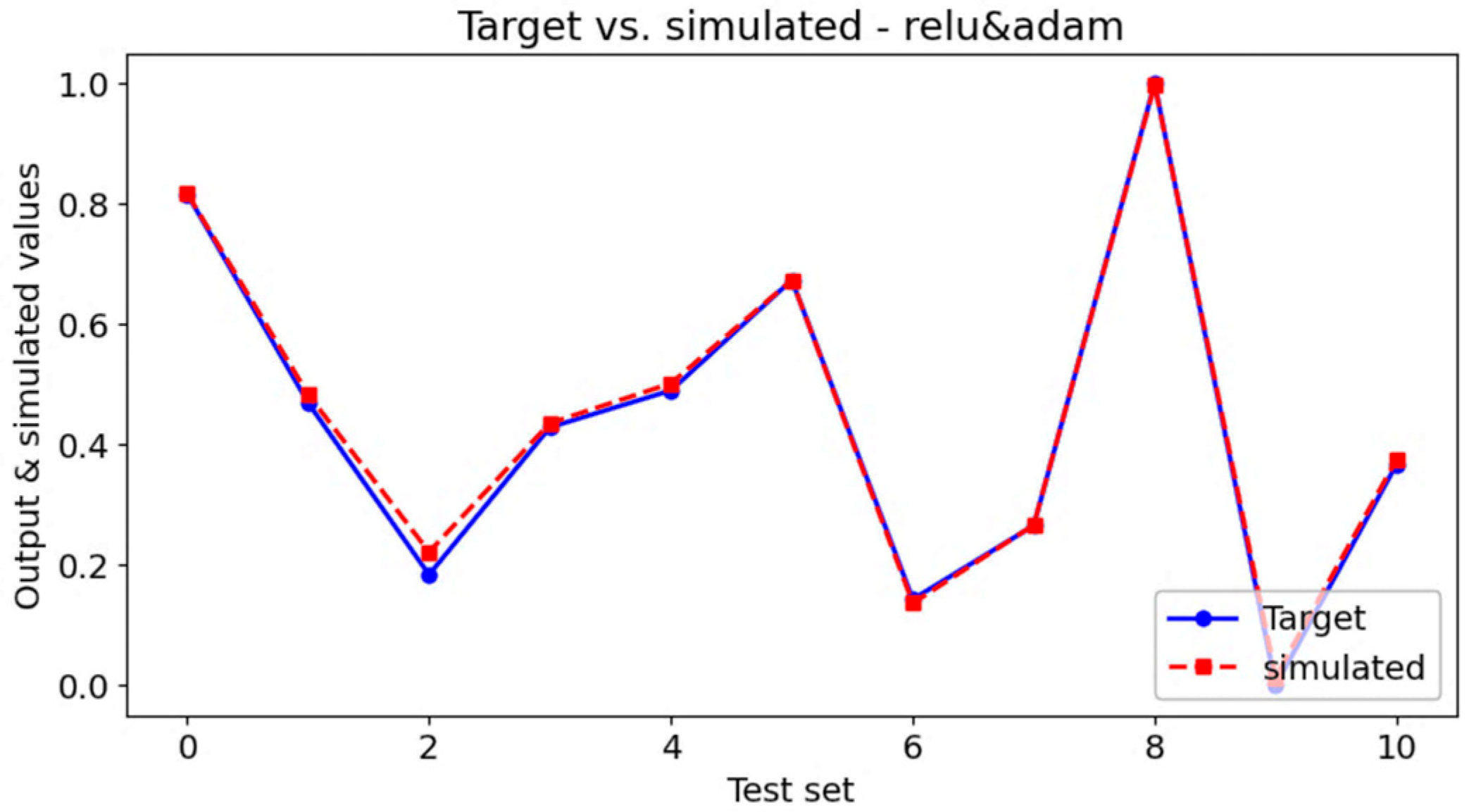To ensure methodological coherence, the study adopts a sequential and complementary dual-method approach that combines statistical analysis with Artificial Neural Networks (ANNs). The rationale for this integration lies in the distinct strengths of each method:
Statistical Analysis (correlation matrices and non-parametric tests) was employed as an initial step to identify significant relationships between variables and the CF. This phase provided objective criteria for variable selection, retaining only indicators with strong correlations (r > 0.7) to ensure analytical rigor.
ANN Modeling was subsequently applied to capture non-linear interactions and assess the relative importance of the selected variables. Unlike traditional statistical methods, ANNs can model complex patterns and provide a hierarchical ranking of influences, offering predictive insights beyond linear assumptions.
2.1. Data
Based on the types of SDGs and the availability of relevant online data, the 17 SGDs considered in this study were grouped into five distinct categories, as was done in the previous chapter. The limitation in both the number of variables and the amount of data available is mainly due to the short period of recording, which reflects the relatively recent emergence of sustainability monitoring as a widespread objective worldwide. Therefore, the data correspond to a limited time frame. The data used in this study include both dependent and independent variables, as presented below, and were retrieved from the Eurostat website for Romania, covering the period from 2012 to 2023.
Romania provides a complete and consistent dataset covering the years 2012 to 2023, which supports the effective use of both statistical and machine learning methods. As a member of the European Union, Romania follows common sustainability targets and policy frameworks, offering relevant insights into areas such as the circular economy, economic growth, and environmental awareness within the EU context. Its status as a transitional economy with shifting consumption patterns makes it a valuable case for examining the relationship between socioeconomic indicators and environmental impact. The methodological framework developed in this study, piloted on Romania, is designed to be replicable and scalable to other EU countries in future research. Furthermore, based on the premise that the present analysis serves as a foundation for future, more in-depth research, the selection of data reflecting Romania’s situation is justified by the authors’ ability to assess the accuracy of the research outcomes, given their comprehensive understanding of the real context from the perspective of the country’s citizens.
Following the categories defined above and combining them with variables that were already recorded and available online, the following variables were identified and assigned to each category. Although some variables span a period beyond 2011–2023, only this interval contains complete data for all variables. Following the categories defined above and combining them with variables that were already recorded and available online, the following variables were identified and assigned to each category.
Gross Domestic Product (
GDP) per capita in Purchasing Power Standards is measured relative to the EU average, set at 100. Values above 100 indicate a higher GDP per capita than the EU average; values below 100 indicate a lower level. While commonly used to compare economic well-being across countries, GDP includes elements that may not fully reflect household living standards. Purchasing Power Standards (PPS), a notional currency used by Eurostat, adjusts for price level differences between countries, enabling meaningful comparisons [
8].
Price Level Indices (
CPI) reflect household final consumption expenditure, adjusted using purchasing power parities (PPPs), and are expressed as an index with the EU-27 average set at 100. A value above 100 indicates relatively higher prices compared to the EU average, while a value below 100 suggests lower prices. The data refer to the EU-27 as defined in 2020, excluding the United Kingdom [
9].
Companies are assessed on how they engage with their employees, including job satisfaction, training, and development opportunities. Creating inclusive spaces where everyone, regardless of background, can thrive is fundamental. This involves ensuring equitable access to resources and opportunities [
10]. The Unemployment Rate (
UNE) represents the share of unemployed individuals within the total labor force, which includes both employed and unemployed persons. Unemployed individuals are defined as those aged 15 to 74 who were without work during the reference week, available to start work within two weeks, and actively seeking employment within the preceding four weeks or had secured a job to begin within three months. This indicator is based on data from the EU Labour Force Survey [
11].
KOF Globalization Index (
KOF) [
12], developed by the KOF Swiss Economic Institute, measures the extent of globalisation in countries across three dimensions: economic, social, and political. It distinguishes between actual flows (de facto) and enabling policies (de jure) and uses over 40 variables to assess integration. Scores range from 1 to 100, with higher values indicating greater globalization. The index is updated annually and is widely used for cross-country comparisons and academic research.
A healthy population is more capable of contributing to sustainable development. Access to healthcare and promoting healthy lifestyles are vital for a strong, sustainable society. Healthy life years at birth by sex (
HLY)—measures the number of years that a person at birth is still expected to live in a healthy condition. It combines information on mortality and morbidity. A healthy condition is defined by the absence of limitations in functioning/disability. The indicator is also called disability-free life expectancy [
13].
Active participation in community initiatives fosters a sense of belonging and responsibility. Community gardens, for example, not only provide fresh produce but also strengthen social bonds and promote environmental stewardship. Share of renewable energy in gross final energy consumption (
SRE). The indicator measures the share of renewable energy consumption in gross final energy consumption according to the Renewable Energy Directive. The gross final energy consumption is the energy used by end-consumers (final energy consumption) plus grid losses and self-consumption of power plants [
14]. The Circular Material Use Rate (
CMU) indicates the proportion of recovered materials reintroduced into the economy relative to total material use. It is calculated as the ratio of the circular use of materials to the overall material use. Circular use is approximated by the amount of waste recycled domestically, adjusted for imports and exports of waste for recovery [
15]. A higher CMU reflects greater substitution of secondary materials for primary raw materials, contributing to reduced environmental impact [
16].
CMU ensuring fairness and equal opportunities for all members of society helps build a more resilient and cohesive community. This includes addressing social inequalities and promoting inclusivity. Persons employed in circular economy sectors (
ECE) indicator measures the number of persons employed in three key circular economy sectors: recycling, repair and reuse, and rental and leasing. Employment is reported both as an absolute number and as a percentage of total employment. It includes all individuals working within the reporting unit (e.g., firm), such as owners, partners, and unpaid family workers, as well as those working externally but paid by the unit. It excludes personnel supplied by other enterprises and those performing external maintenance or serving in compulsory military service [
17].
The Consumption Footprint indicator assesses the environmental impact of EU consumption using life cycle data from approximately 165 representative products across five sectors: food, mobility, housing, household goods, and appliances. It combines product-specific consumption intensity with emissions and resource use, applying the Environmental Footprint method to quantify 16 impact categories. These are aggregated into a single score that reflects how often planetary boundaries are exceeded [
18].
This clustering approach aligns with previous studies that emphasize multidimensional influences on sustainability [
6,
7].
To identify the most influential indicators affecting the CF, a preliminary correlation analysis was conducted across all available socioeconomic and environmental variables, involving constructing a correspondence matrix that quantifies the strength of correlations in numerical form. The correlations are considered stronger as their values increase, as illustrated in
Figure 1. Only those variables with a correlation coefficient greater than 0.7 with CF were retained for detailed analysis, ensuring a statistically significant and meaningful relationship with the target variable. Based on this criterion, four variables were selected: Gross Domestic Product (GDP), Price Level Indices (CPI), Unemployment Rate (UNE), and Circular Material Use Rate (CMU).
Figure 1a displays all variables, while
Figure 1b includes only those variables with a correlation coefficient of 0.7 or higher with respect to CF.
For easier presentation and to simplify tracking the research, from now on the use of all independent variables in methods and algorithms will be denoted as all_var, while the use of only the four independent variables considered more influential will be denoted as 4_var. From this point onward, all analyses concerning the variables will be conducted for both the all_var and 4_var datasets, thereby enhancing analytical clarity and methodological rigor.
To assess the internal consistency of the data, their heterogeneity, potential common variations, or simply to observe the correlations among variables, several tests were implemented. The lack of strong correlations between certain variables prompted the application of a wide range of tests in an effort to identify possible relationships. The tests applied are as follows:
Cronbach’s Alpha—used to assess internal consistency.
Shapiro–Wilk Test—tested for normality.
Bartlett’s Test—assessed homogeneity of variances.
Kruskal–Wallis and Mann–Whitney U Tests—used to detect differences between groups.
The detailed methodological explanations, which include formulas, assumptions, and interpretation guidelines, are presented in
Appendix A.
The reliability analysis of the scale reveals significant issues, as indicated by the negative Cronbach’s alpha values. For the full scale of values (all_var), the alpha is −1.785 with a confidence interval ranging from −4.969 to 0.061. This suggests severe inconsistency, potentially due to small amount of data. The confidence interval includes zero, further emphasizing the unreliability of the scale. Similarly, for the subset (4_var), the alpha is −2.448 with a confidence interval entirely below zero [−6.935, −0.132]. The analysis shows that is a very low or zero variance (items have little, the covariance matrix becomes unstable) or there are too few items or small sample size (with very few items or a small number of observations, alpha can behave erratically). These results strongly suggest that the data requires further analysis.
For the full sample (all_var), the test statistic is 0.856 with a p-value of 7.84 × 10−9, indicating a significant deviation from a normal distribution. Similarly, for the subset of four groups (4_var), the test statistic is 0.878 and the p-value is 2.26 × 10−5, again rejecting the null hypothesis of normality. These consistently low p-values confirm that the data does not follow a normal distribution, which has important implications for the choice of statistical methods. Non-parametric approaches may be more appropriate given these results.
The Bartlett’s test results indicate significant heterogeneity of variances across the groups. For the full dataset (all_var), the test statistic is 177.27 with an extremely low p-value of 3.85 × 10−34, strongly rejecting the null hypothesis of equal variances. Similarly, for the subset of four groups (4_var), the test statistic is 64.68 with a p-value of 3.00 × 10−13, again confirming significant differences in group variances. These findings provide strong evidence of heteroscedasticity and suggest that the assumption of homogeneity of variances is debased. Given the small sample size and the lack of normality, parametric tests such as ANOVA or t-tests may not be appropriate. Instead, non-parametric alternatives like the Kruskal-Wallis test or the Mann-Whitney U test should be considered for more reliable statistical inference.
The results of the analysis conducted using the two selected tests are summarized in
Table 1.
The results of both the Kruskal-Wallis and Mann-Whitney U tests indicate statistically significant differences across groups for most indicators, including GDP, CPI, UNE, KOF, HLY, SRE, and ECE, as evidenced by extremely low p-values.
These findings suggest that these variables vary meaningfully between the compared groups. However, the CMU indicator does not show significant differences in either test, indicating a lack of variation across groups for this variable. Overall, the consistency between the two non-parametric tests reinforces the robustness of the observed differences and supports the use of non-parametric methods given the data characteristics.
Based on the results of the applied tests and the observation of significant nonlinearity in the evolution of the variables, it was deemed necessary to apply specific methods, which are presented in the following subsection.
2.2. Methods
The present research employs two distinct methodological approaches. The first method involves applying graphical representation techniques to observe the evolution of the dependent variable (CF) in relation to the four selected independent variables (GDP, CPI, UNE, CMU). The second method employs Artificial Neural Networks (ANN), a branch of Artificial Intelligence, to determine the hierarchy of the observed influences. To illustrate the evolution of each indicator and to concatenate these trends, several Python (version 3.11) modules and functions were utilized. Among the key tools applied within the first method are:
sns.lineplot—Plots a line plot with possibility of several semantic groupings [
19].
sns.jointplot—Draws a plot of two variables with bivariate and univariate graphs [
20].
sns.regplot—The regplot generates a single scatter plot of data with a linear regression through the data points complete with a 95% confidence interval [
21].
corrmat—Creates a correlation Matrix. Correlation matrix is a table that shows how different variables are related to each other [
22].
curve_fit—Uses non-linear least squares to fit a function [
23]. Due to the small number of values and their distribution, a fourth-degree function was used.
ax.plot_surface—Creates a surface plot [
24].
np.polyfit—is a function that performs least squares polynomial fitting. It fits a polynomial of a specified degree to a set of data points, minimizing the squared error between the polynomial and the data [
25].
For the second method, the ANN used is a feedforward type implemented with MLPRegressor (Multi-Layer Perceptron Regressor), both well-known and widely used variants. MLPRegressor is a supervised learning algorithm in the scikit-learn library used for regression tasks [
26]. It models complex relationships between input features and a continuous target variable by training a feedforward neural network. The model optimizes the squared error using either the Limited-memory Broyden–Fletcher–Goldfarb–Shanno algorithm or stochastic gradient descent (SGD), and supports various activation functions such as ReLU, tanh, and logistic. It is particularly useful for capturing non-linear patterns in data and can be customized with multiple hidden layers and neurons.
To determine the optimal internal structure of the ANN (i.e., the number of hidden layers and hidden neurons), several configurations were tested and evaluated, examples of these structures are shown in
Figure 2. The selected variant is presented in
Section 3—Results. The general characteristics used across all these internal structures are summarized in
Table 2.
ReLU (Rectified Linear Unit Activation Function) outputs the input if positive, otherwise zero [
27]. It’s fast and widely used in deep learning. Tanh (Hyperbolic Tangent Activation Function) maps input values to the range (−1, 1). It’s smoother than ReLU and often used in recurrent neural networks [
28]. The adam solver (short for Adaptive Moment Estimation) is a popular optimization algorithm used in training machine learning models, especially deep neural networks [
29]. SGD (Stochastic Gradient Descent Optimizer) is a basic optimization algorithm that updates model parameters using gradients from random batches. It can be enhanced with momentum and learning rate decay [
30].
The dataset was divided into training and testing subsets using the parameter test_size = 0.05, which resulted in a testing set containing only a single value. This configuration was necessitated by the limited number of training sets (12) and the authors’ intention to prioritize the training process. Consequently, it was considered that calculating the R2 score for the testing phase would offer limited relevance for evaluating the performance of the artificial neural network (ANN). Also, due to the limited sample size k-fold cross-validation was not applied.
The final structure selected for further application will be detailed in the following chapter and is based on the evaluation of both training error and training score.
